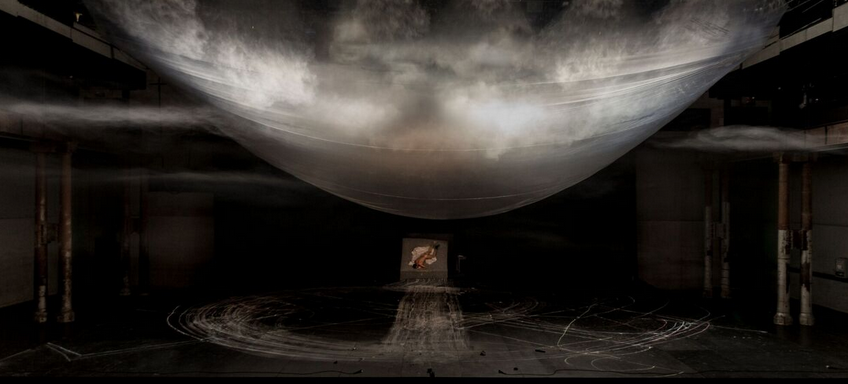A man sits on a chair holding a rock, staring out at the world. Above him a cloud-filled meniscus; all around him grey, empty nothingness. He dusts himself off, and then, agonisingly slowly, begins to drag a huge slab of rock towards the foreground. For this is Sisyphus, in Greek mythology the king of Corinth punished for his trickery by being banished to Tartarus. Condemned to roll a boulder up a hill every day, his fate was to endlessly watch it roll back again. And so on for all eternity.
In Dimitris Papaioannou’s striking visual take on the story, Sisyphus’ labours are intensified. Amplified sounds of rock against rock set our teeth on edge as the edifice crumbles bit by bit. The slab becomes an assault course, the prisoner literally burrowing into the surface while another figure morphs out of it, the top half of one cleverly complementing the bottom half of the other like two pieces of a human jigsaw. Mirror images writhe and contort on the surface before the edifice falls, leaving a pair of feet comically poking out from underneath. The condemned man remains defiant, for he is after all a worker with a worker’s pride in his labours.
 Still Life. Photo by Julian Mommert
Still Life. Photo by Julian Mommert
Over the following hour and a half Papaioannou presents a series of absurdly futile images, populating his bleak landscape with a whole troupe of workers. Each strives for something unattainable, some way out of their purgatorial prison, or some means to build their personal stairway to heaven. The Greek director – best known outside of Greece as the creator of the Athens Olympic opening and closing ceremonies – blends physical theatre and commedia dell’arte to depict the various denizens of Still Life and project their desperation and humanity in equal degrees.
Unfortunately, the Sisyphus segment is as good as it gets. None of the subsequent scenarios – each of which takes about 15 minutes to play out, yet seems to drag on for twice as long – quite captures the visual impact or the gallows humour of the opening. A woman withdraws step by step behind a sheet of perspex held by a man who wobbles it, making her dress flutter. A man carries rocks, which he drops one by one, before balancing on a ladder in a rudimentary clowning routine. Another man advances, shovelling up his own footsteps as he walks, before a woman stands on his bare buttocks and he shuffles slowly off – why, I have no idea.
The man who tries to build an impossible set of steps out of breeze blocks engages our hearts momentarily with his optimistic futility, but the whole company pulling up masking tape from the floor for what feels like half an hour creates a fleeting visual impression but little more. Of course, the endless repetition is part of the point of Still Life, but many of the audience, to judge by the fair few who made their escapes somewhere around the 40-minute mark, felt as trapped as the cast.
Papaioannou is blessed with a strong sense of the visual, but the work as a whole feels ill-disciplined and drawn out. Too many of these images feel like improvised ideas from the rehearsal room that should have been jettisoned in favour of more imaginative and involving sequences. Instead, you are left wondering why nothing taps into the rich vein of eternal torments catalogued in Greek myth. Where was Tantalus beneath his ever-unreachable fruit tree? Where was Ixion on his wheel? Where were the Danaides endlessly trying to fill their cracked bath? And while Still Life may share a sense of everywhere and nowhere with Samuel Beckett, Waiting for Godot is action-packed by comparison.
The final scene, with four men carrying a laden table on their heads, is badly mistimed, drawing awkward applause from many who assumed the show was over. By the time the action had pulled focus back again, half the audience were out of the door. The lucky half, some might say.
Still Life is at Carriageworks until January 29











Comments
Log in to join the conversation.